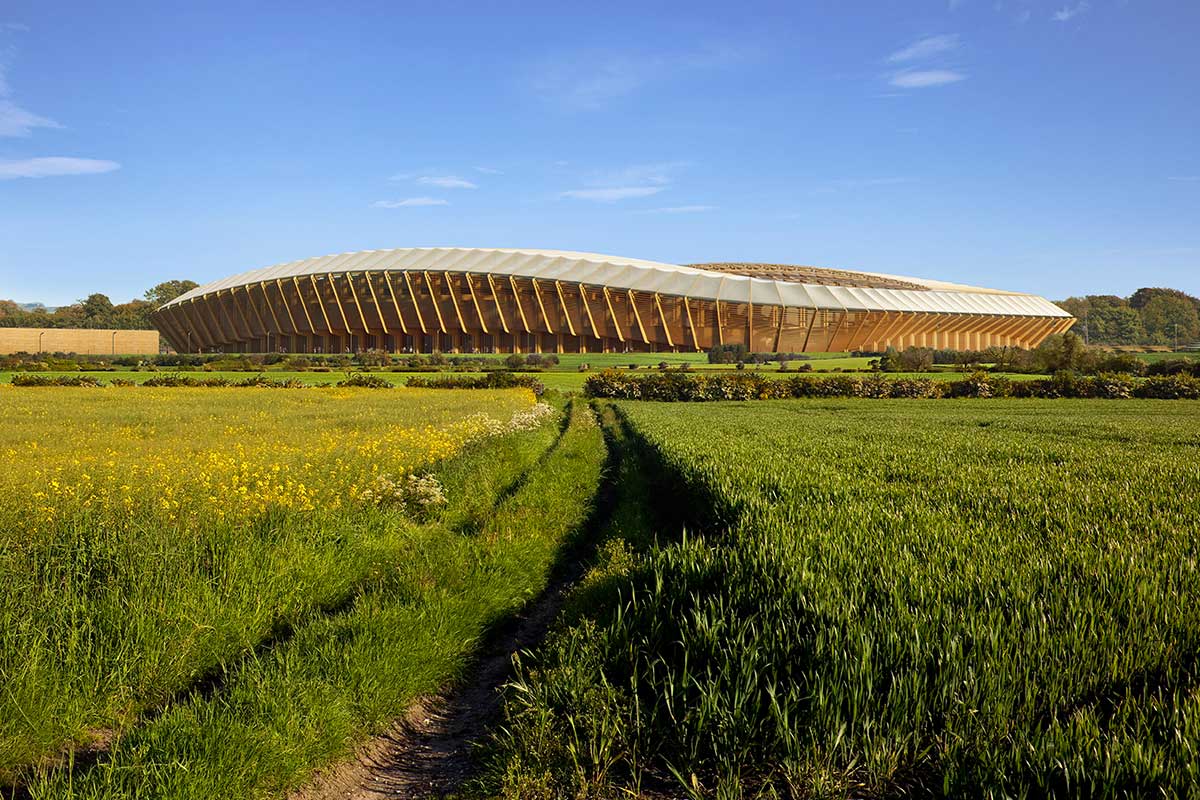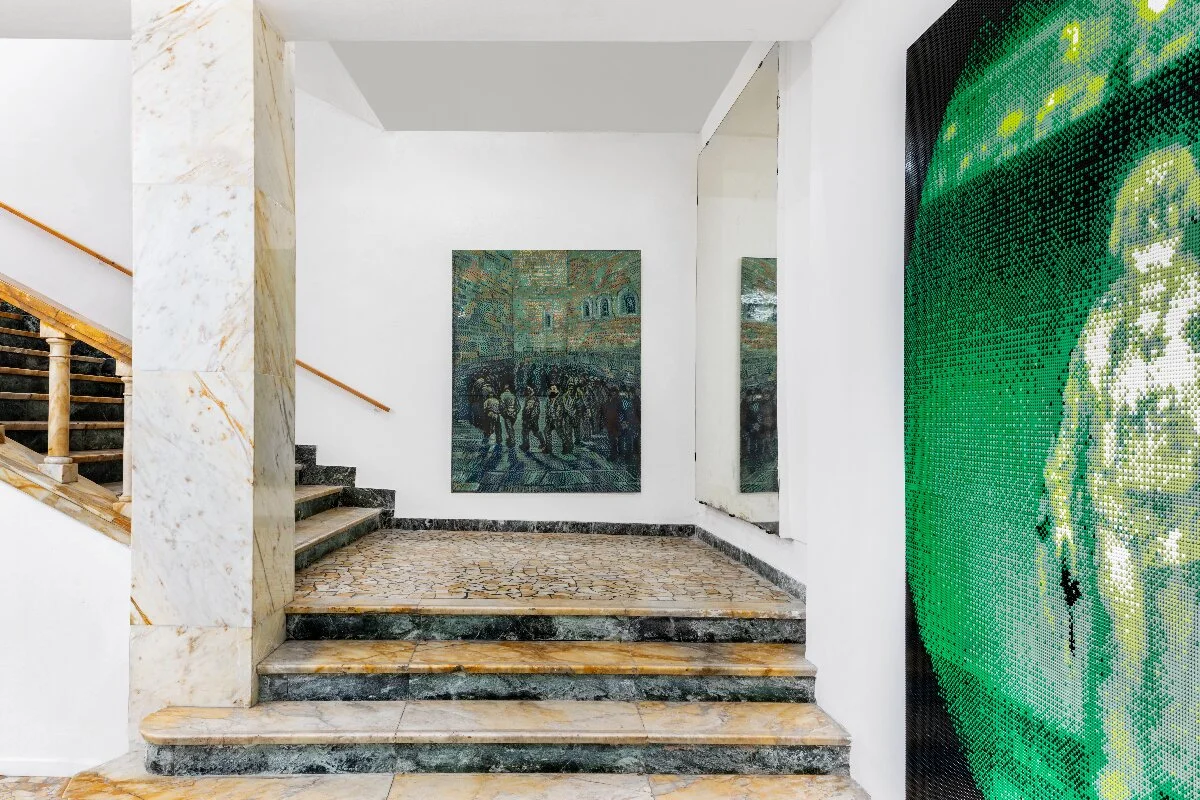Dale Vince, chairman of the team «using the club to demonstrate that you can enjoy sports, and supporters can have their consumerism, but you can still do it in a way that is sustainable»
The Eco Park Stadium by Zaha Hadid Architects
In 2016 Zaha Hadid Architects (ZHA) was selected to design the new Five-thousands-seat stadium for the Forest Green Rovers football team. The stadium named Eco Park Stadium will be built in Stroud, Gloucestershire in the UK and will be the world’s first wooden stadium. Entirely constructed in timber, ZHA goal is for it to be the first green stadium ever built, entirely powered with renewable and locally produced energy.
Since the 2016 open competition that saw ZHA winning the project, according to Jim Heverin, project director at ZHA and lead architect for the stadium, «little has happened. The site where the stadium will be built is a greenfield site designated for agriculture», which makes the acceptance process complicated.
The design proposed by Heverin and his team was first refused in 2019, and then got approved a couple of months later, after making some adjustments: «there were concerns from local residents about traffic and noise, about match days». Then came the approval from the English Football League. The next step, which is the detailed planning application, is not going to be pursued by the commissioner before next year, so «we’re looking about a couple of years before construction starts».
Lampoon review: Cross Laminated Timber (CLT) usage
The stadium will be built with Cross Laminated Timber (CLT). CLT will be used for the beams of the roof and of the seating boots, as well as for the terraces and «everything above the ground». CLT has many positive features: it is low carbon, resistant and durable, but there are also a number of issues in its application, especially in the UK.
After the Grenfell Tower fire in 2017 the government has enforced much stricter regulations when it comes to «combustible materials». CLT is an engineered product whose elaboration makes it fire-resistant, but it is still timber in its raw form, and as such considered combustible. According to Hevering in the UK there is currently «a lot of nervousness about using CLT». Still, «if we are to reach our 2030 goals for the climate, timber must be included».
Another issue is the sourcing of the material: there is currently no one producing it in the UK, making it impossible to source it locally. The environmental costs of transportation risk jeopardizing its positive characteristics for the ecosystem. The stadium will be covered by a transparent membrane. ZHA has not yet decided what material this will be made of: «Ethylene Tetrafluoroethylene (EFTE) would be the most obvious choice», but it has problems. It might not be a strong enough material – and you have to prove people can walk on it without danger for maintenance reasons.
The sourcing of the material
PVC is also being considered, despite its much less attractive nature in terms of sustainability. «the ambition is to do something that allows the light to come through and lets you see the timber». Aesthetics are also valued, in a context in which «a lot of sensibility about how the stadium blends with the natural environment» has been registered on the community side. As Heverin points out, although in stadium projects like this one, roughly «three quarters is embedded carbon».
Which is to say used for construction and inherent in the building, and only «a quarter is energy in use», including mainly lightning and some air conditioning. To cover those, solar panels will be used. Organic waste from grass cutting and food consumption will be collected and set to decompose to be used as fertilizer. Energy will also potentially be extracted from it through pyrolysis, though specific plans have not been made yet. Rainwater will be harvested and reused for toilets and all other implants that will require it on site.
The relationship between commissioner and low-carbon solutions
The client for this project is Dale Vince, Chairman of Forest Green Rover, who is also the owner of Ecotricity, a British electricity provider company founded in 1995, that aims, according to their website, to «replace fossil fuels with green energy». They started out with one windmill in Gloucestershire and went on building solar and wind parks across the UK. They now have sixteen wind and three solar parks operating in England. When it came to build a new stadium for its football team, Vince already had sustainability in mind as a priority.
The architect explains how the commitment to the sustainability of construction projects must start from the commissioner. ZHA had started looking into green solutions also for Al Janoub stadium in Qatar back in 2014, but at that time the clients decided to drop sustainable solutions in favor of cutting costs. Al Janoub caused a lot of criticism against ZHA, but Heverin argues that it should be the government enforcing policies, and not architects to push for the implementation of materials and techniques that have less impact on the environment: «they’ll need to be told to do it».
Reconsidering the space around the stadium in order to fund the construction
Heverin says he is conscious that «we need to have this conversation with every client» and ZHA is starting a process to measure their own portfolio to see where they are in terms of sustainability. In terms of policy change, the Royal Institute of British Architects set a series of building targets that architects will have to commit to by 2025, which, Heverin admits, «are far from what we are doing in our average projects». In the case of the Eco Park Stadium they met a client who already knew what they wanted, so they didn’t have to make much of an effort to convince him. Vince was already ready to sacrifice timings and cheaper costs in favor of quality.
Though it will slow down the process, Vince is now looking into reconsidering the space around the stadium in order to fund the construction: «we’re not involved but I can only presume that the client is thinking about selling off land adjacent to the stadium which would then be part of the capital that’s required for the construction» says Heverin. Vince has also arranged for the site of the stadium where the club currently plays, Innocent New Lawn, to be transformed into low-carbon housing, including open spaces and greenery. The newly created homes will be connected by public transportation and charging points for electric cars and bicycles will be present in the neighborhood. Affordable housing will be included in the project.
The Forest Green Rover Club ongoing commitment
The Forest Green Rover club itself stands for a commitment to respecting – or at least not damaging – the environment. In 2010, when Vince was appointed chairman of the club, he started getting the club to live by his values. For the past two years the food policy has been vegan only – both for the players and for spectators on match days, meaning only vegan meals are served in the stadium.
The team’s kit is made with recycled materials: it was made with bamboo fibers in the past but has switched to coffee beans fiber last year. This is both for the ones used by the players and sold to fans. According to Heverin. If all other football clubs were to follow, the sports industry could only become greener.
Zaha Hadid Architects
Zaha Hadid Architects is formed by 400 architects of 55 nationalities working on projects in 44 different countries.




















